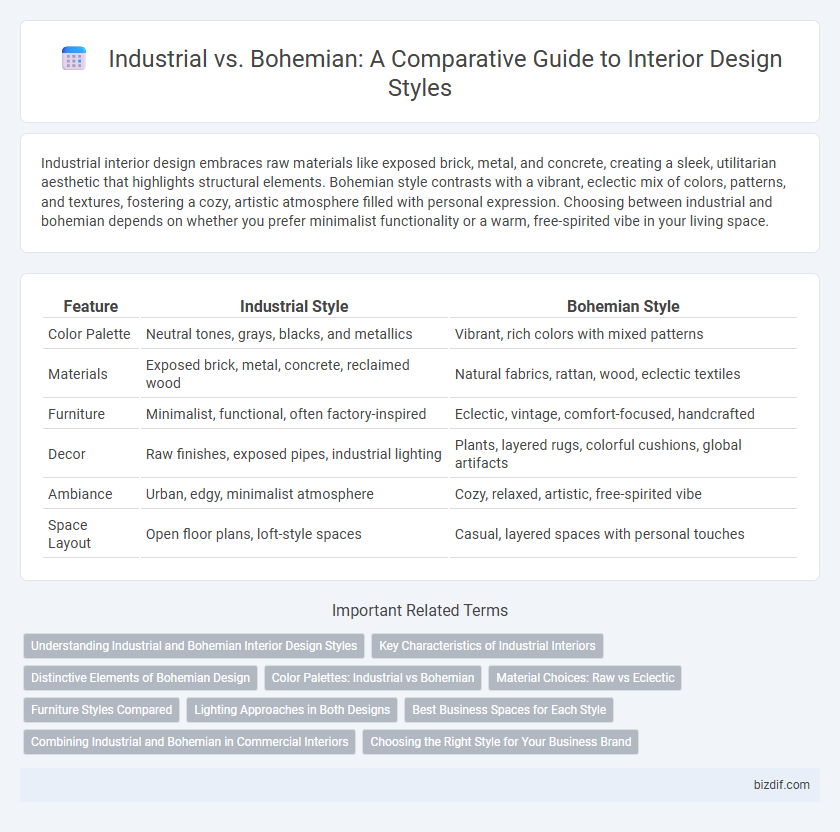Industrial interior design embraces raw materials like exposed brick, metal, and concrete, creating a sleek, utilitarian aesthetic that highlights structural elements. Bohemian style contrasts with a vibrant, eclectic mix of colors, patterns, and textures, fostering a cozy, artistic atmosphere filled with personal expression. Choosing between industrial and bohemian depends on whether you prefer minimalist functionality or a warm, free-spirited vibe in your living space.
Table of Comparison
| Feature | Industrial Style | Bohemian Style |
|---|---|---|
| Color Palette | Neutral tones, grays, blacks, and metallics | Vibrant, rich colors with mixed patterns |
| Materials | Exposed brick, metal, concrete, reclaimed wood | Natural fabrics, rattan, wood, eclectic textiles |
| Furniture | Minimalist, functional, often factory-inspired | Eclectic, vintage, comfort-focused, handcrafted |
| Decor | Raw finishes, exposed pipes, industrial lighting | Plants, layered rugs, colorful cushions, global artifacts |
| Ambiance | Urban, edgy, minimalist atmosphere | Cozy, relaxed, artistic, free-spirited vibe |
| Space Layout | Open floor plans, loft-style spaces | Casual, layered spaces with personal touches |
Understanding Industrial and Bohemian Interior Design Styles
Industrial interior design emphasizes raw materials, exposed brick walls, metal fixtures, and a minimalist aesthetic rooted in urban lofts and factories. Bohemian style contrasts this with eclectic decor, vibrant colors, layered textiles, and a mix of cultural influences that create a warm, personalized, and relaxed atmosphere. Understanding these core elements helps in making design choices that either highlight structural authenticity or embrace artistic freedom.
Key Characteristics of Industrial Interiors
Industrial interiors showcase raw materials such as exposed brick walls, metal fixtures, and reclaimed wood, emphasizing a utilitarian and unfinished aesthetic. High ceilings and open floor plans enhance the spacious, loft-like atmosphere, while neutral color palettes of grays, blacks, and browns dominate the design scheme. Functional lighting with exposed bulbs and vintage-inspired furniture elements contribute to the rugged and minimalist appeal of industrial spaces.
Distinctive Elements of Bohemian Design
Bohemian design is characterized by its eclectic mix of colors, patterns, and textures that create a warm, inviting atmosphere. Key elements include layered textiles, vintage furniture, and an abundance of plants, which contribute to its relaxed and artistic vibe. This style emphasizes personal expression and cultural influences, contrasting sharply with the sleek, utilitarian aspects of industrial design.
Color Palettes: Industrial vs Bohemian
Industrial color palettes emphasize neutral tones such as grays, blacks, and metallics to create a raw, urban atmosphere. Bohemian color schemes incorporate vibrant hues including rich reds, deep blues, and earthy greens, fostering a warm, eclectic vibe. These contrasting palettes define the unique aesthetic and mood of Industrial and Bohemian interior designs.
Material Choices: Raw vs Eclectic
Industrial interior design emphasizes raw materials such as exposed brick, concrete, and metal, creating a rugged and unfinished aesthetic. Bohemian style embraces eclectic material choices, featuring a mix of natural fibers, vibrant textiles, and handcrafted accents that add warmth and personality. Selecting materials in industrial decor leans toward durability and minimalism, while bohemian design prioritizes diversity and artistic expression.
Furniture Styles Compared
Industrial furniture features raw materials like metal, reclaimed wood, and exposed hardware, emphasizing functionality and rugged aesthetics. Bohemian furniture incorporates eclectic, colorful textiles, vintage pieces, and handcrafted items, creating a cozy and artistic atmosphere. Both styles reflect distinct design philosophies, with industrial focusing on minimalism and durability, while bohemian celebrates individuality and creativity through diverse patterns and textures.
Lighting Approaches in Both Designs
Industrial interior design emphasizes lighting fixtures with raw materials such as exposed bulbs, metal shades, and pendants that highlight structural elements and create a utilitarian ambiance. Bohemian lighting incorporates layered, eclectic sources like string lights, lanterns, and colorful lampshades to foster warmth, creativity, and a relaxed atmosphere. Both styles utilize lighting as a key element, with Industrial favoring functionality and minimalism, while Bohemian focuses on texture and visual interest.
Best Business Spaces for Each Style
Industrial interior design suits business spaces such as tech startups, design studios, and loft-style offices where exposed brick, metal fixtures, and open ceilings create a raw, urban atmosphere fostering creativity and collaboration. Bohemian style thrives in boutique shops, creative agencies, and cozy cafes, offering eclectic decor with vibrant colors, textured fabrics, and vintage furniture that inspire individuality and relaxed client interactions. Choosing the right style depends on the brand identity and the desired ambiance to enhance productivity and customer experience.
Combining Industrial and Bohemian in Commercial Interiors
Combining industrial and bohemian styles in commercial interiors creates a dynamic balance between raw, utilitarian elements and vibrant, eclectic decor. Exposed brick walls, metal accents, and concrete floors contrast with colorful textiles, plants, and vintage furniture to foster a unique, inviting atmosphere. This fusion not only enhances visual interest but also appeals to diverse clientele seeking both modern edge and artistic warmth.
Choosing the Right Style for Your Business Brand
Industrial interior design emphasizes raw materials like exposed brick, metal, and reclaimed wood, creating a modern, edgy atmosphere that aligns well with tech startups and creative agencies aiming for a minimalist, urban vibe. Bohemian style incorporates vibrant colors, eclectic furnishings, and artisanal decor, perfect for brands seeking a relaxed, artistic, and culturally rich environment that fosters creativity and individuality. Selecting between these styles depends on your brand identity, target audience, and the emotional experience you want to evoke within your commercial space.
Industrial vs Bohemian Infographic

 bizdif.com
bizdif.com